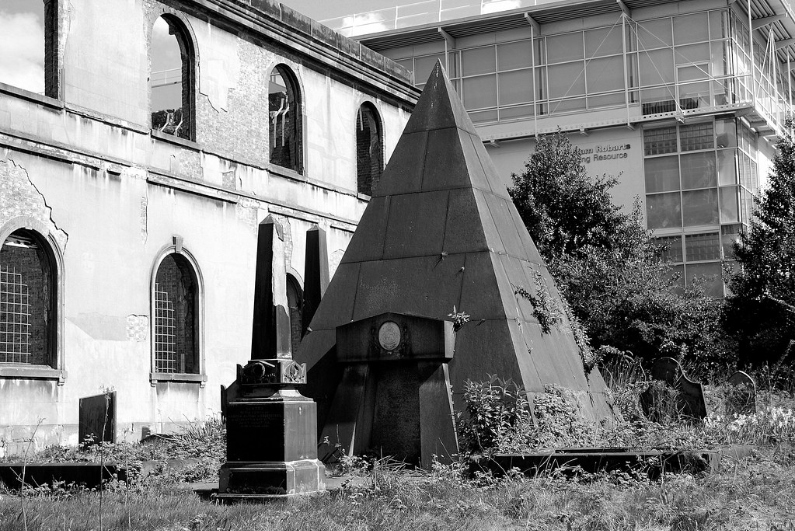
All on the line
The gambling world is full of mysterious, terrifying, and wonderful stories, from bizarre bad beats to hair-raising heists, murders, and even ghosts. When it comes to spooky gambling antics, the tale of gambler William Mackenzie – whose remains are inside a 15-foot pyramidal tomb in Liverpool, England – is hard to beat.
Mackenzie lost his soul to the Devil in a game of poker
The gambler’s tomb is situated in the graveyard of St Andrew’s Church on Rodney Street. Legend has it, that Mackenzie lost his soul to the Devil in a game of poker. Once he died and his body was buried, the deal stipulated that Mackenzie’s soul would descend with the Devil back down to hell.
However, the story goes that Mackenzie had an ingenious way of ensuring he never had to follow through on his part of the deal.
The story of Mackenzie
Born in 1794, Mackenzie – originally from Nelson, Lancashire – initially started his career as an apprentice weaver before changing to civil engineering. Moving to Liverpool, he enrolled as a lock carpenter on the Leeds and Liverpool Canal in 1811.
It was during his work on the canal and railway projects in Belgium, France, and Spain that the avid gambler made his fortune. Mackenzie died in 1857, the eldest of 11 children, at the age of 57 – but not before he supposedly lost his poker game with the Devil.
cheated Satan out of claiming his immortal soul
The story, which is often told as the sworn truth, claims that upon Mackenzie’s death, he left instructions stating that he should be placed inside the tomb above ground, holding a winning hand of cards while sitting at a card table. With his skeletal remains not buried, he cheated Satan out of claiming his immortal soul.
To add to the myth surrounding Mackenzie’s pyramid tomb, locals and tour guides claim that his ghost has been seen roaming the churchyard and the nearby area. His troubled spirit is said to appear at dusk to haunt Rodney Street as night begins to fall.
Fact or fiction?
While the story of Mackenzie’s tomb has remained a popular tale over the years, it is probably a far stretch from the truth. In reality, his tomb was erected 17 years after Mackenzie’s death by his brother Edward in 1868 following the death of Mackenzie’s second wife Sarah in 1867.
Nevertheless, many locals still believe the tale of Mackenzie wholeheartedly. When visiting Liverpool, it’s possible for people to see the pyramid tomb of Mackenzie which remains in the graveyard of St Andrew’s Church. Even though the tomb is gated off, visitors can easily spot the monument.
Not the only pyramid tomb
Mackenzie’s tomb is not the only one that’s shaped like a pyramid.
a twenty-five-foot pyramid dedicated to John “Mad Jack” Fuller
In East Sussex in Brightling, St Thomas à Becket’s churchyard has a twenty-five-foot pyramid dedicated to John “Mad Jack” Fuller, a founding member of the Royal Institution and a member of parliament in the UK.
According to local legend, Fuller was buried in the pyramid in full dress and a top hat, seated at a table complete with a roast chicken and a bottle of wine. It wasn’t until renovations in 1982, though, that this was discovered to be untrue.
- SEO Powered Content & PR Distribution. Get Amplified Today.
- PlatoData.Network Vertical Generative Ai. Empower Yourself. Access Here.
- PlatoAiStream. Web3 Intelligence. Knowledge Amplified. Access Here.
- PlatoESG. Automotive / EVs, Carbon, CleanTech, Energy, Environment, Solar, Waste Management. Access Here.
- PlatoHealth. Biotech and Clinical Trials Intelligence. Access Here.
- ChartPrime. Elevate your Trading Game with ChartPrime. Access Here.
- BlockOffsets. Modernizing Environmental Offset Ownership. Access Here.
- Source: https://www.vegasslotsonline.com/news/2023/09/06/against-all-odds-the-gambler-who-used-a-pyramid-tomb-to-cheat-the-devil/
- 11
- 17
- 60
- 9th
- a
- above
- add
- after
- age
- aged
- also
- an
- and
- ARE
- AREA
- as
- At
- back
- bad
- BE
- been
- before
- Belgium
- believe
- body
- buried
- but
- by
- CAN
- card
- Cards
- Career
- changing
- Children
- church
- civil
- claim
- claiming
- claims
- comes
- complete
- deal
- death
- December
- dedicated
- descend
- died
- discovered
- down
- During
- easily
- East
- Edward
- Engineering
- England
- ensuring
- even
- fall
- far
- Fiction
- follow
- Following
- For
- Fortune
- founding
- France
- from
- full
- Fuller
- Gambling
- game
- gated
- Ghost
- goes
- Ground
- Guides
- had
- hand
- Hard
- has
- hat
- he
- his
- holding
- HTTPS
- in
- initially
- INSIDE
- Institution
- instructions
- Is
- IT
- john
- jpg
- just
- left
- lie
- like
- liverpool
- local
- lost
- love
- made
- many
- member
- memory
- moving
- never
- Night
- not
- October
- of
- off
- often
- on
- once
- One
- only
- or
- originally
- out
- over
- Parliament
- part
- People
- plato
- plato data intelligence
- platodata
- platogaming
- Poker
- Popular
- possible
- probably
- projects
- Reality
- remained
- remains
- royal
- Said
- second
- see
- seen
- shaped
- should
- Sitting
- situated
- Soul
- Spain
- spirit
- Spot
- ST
- started
- stating
- still
- Stories
- Story
- street
- surrounding
- table
- tale
- that
- The
- The Vault
- this
- though
- Through
- to
- token
- top
- tour
- truth
- Uk
- until
- upon
- Vault
- visitors
- was
- way
- when
- while
- WHO
- wholeheartedly
- whose
- william
- Wine
- winning
- with
- Work
- world
- would
- years
- zephyrnet











